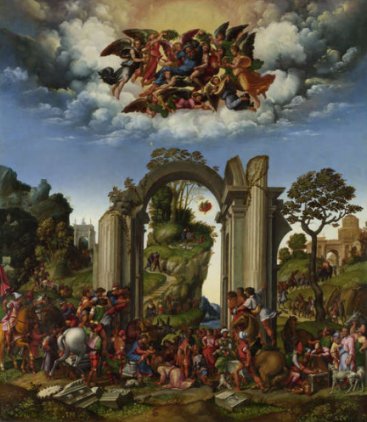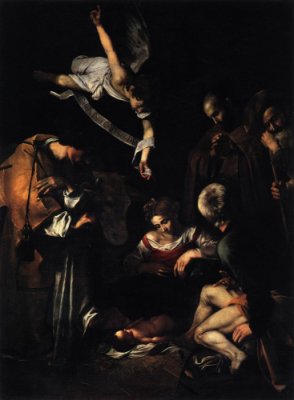|
|
|
|
Later
images moved away from narrative and offered a more devotional, mystical
response to the Nativity, culminating in pictures known as The
Adoration of the Christ Child, which I will discuss
here. It is a move from the simple, bucolic world of Luke's
shepherds and mangers to the grander, more symbolic world of Matthew's Magi
and heavenly portents. |
|
|
|
|
|
|
|
|
Ruined buildings
For because that the world was in so great peace, the
Romans had done made a temple which was named the Temple of Peace, in
which they counselled with Apollo to know how long it should stand and
endure. Apollo answered to them that, it should stand as long till a maid
had brought forth and borne a child. And therefore they did do write on
the portal of the Temple: Lo! this is the temple of peace that ever shall
endure. For they supposed well that a maid might never bear Bethlehem,
there may ye find him wrapt in clouts. But in the very night when Mary
bore Christ, the temple crumbled to the ground, and on its site the church
of Santa Maria Nuova stands today. |
|
|
|
|
|
Few paintings demonstrate the change from
simple storytelling to mystical symbolism as well as Botticelli's Mystic
Nativity. The Greek text at the top of the painting is an element almost unheard of in art - the artist is giving us a meditation on his own work. A translation is: This picture, at the end of the year 1500, in the troubles of Italy, I Alessandro, in the half-time after the time, painted, according to the eleventh chapter of Saint John, in the second woe of the Apocalypse, during the release of the devil for three-and-a-half years; then he shall be bound in the twelfth chapter and we shall see him buried as in this picture. The painting thus has two themes: the nativity of Christ, and his second coming as predicted in the book of Revelation. So why the return to the cave image? Because it is familiar from images of Christ's tomb in paintings of Christ's resurrection. 1490 - 1500 was a 'time of tribulation' in Florence and Italy as a whole, with a French invasion, the exile of Piero Medici, and above all the apocalyptic preaching of Savanarola, under whose spell Botticelli had fallen. By 1498The Florentines had finally had enough of him: the fiery preacher was tortured and burnt at the stake. His predictions, though, were still in the mind of Botticelli: 'The half time after the time' comes from Revelation 12 v14, and was interpreted at the time as 1500 - the date of the apocalypse, and the devils are waiting at the bottom of the picture to drag sinners down to Hell. Well, like all of these predictions so far, it didn't happen. But it is an uncomfortable, apocalyptic painting. The angels at the top may offer us hope, but the jagged, twisting tortured ground below tells a different story. |
|
|
On to some further thoughts on images of the Nativity Nativity Index |
|




